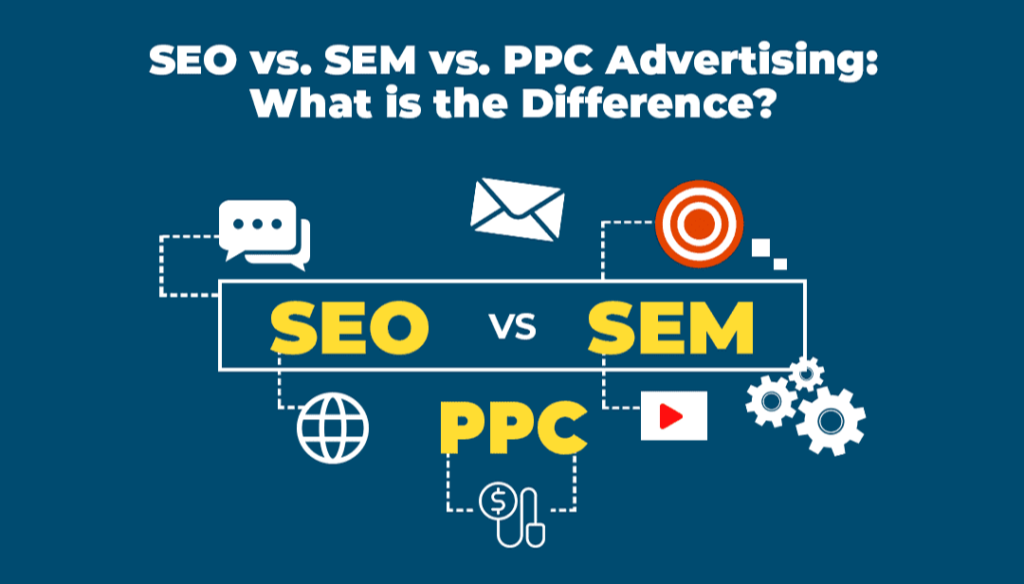Introduction: In the realm of digital marketing, Search Engine Optimization (SEO), Search Engine Marketing (SEM), and Pay-Per-Click (PPC) advertising stand as pillars of online visibility and customer acquisition. While these strategies share the common goal of driving traffic to websites, they employ distinct methodologies and offer unique benefits. This article aims to elucidate the differences between SEO, SEM, and PPC, providing clarity on their definitions, mechanisms, and strategic implications for businesses navigating the digital landscape.

Understanding Search Engine Optimization (SEO)
Search Engine Optimization (SEO) is the practice of optimizing a website to enhance its visibility and ranking in organic (unpaid) search engine results. SEO focuses on improving factors such as content relevance, website authority, and user experience to attract organic traffic from search engines like Google, Bing, and Yahoo.
Key Characteristics of SEO:
- Organic Visibility: SEO aims to improve a website’s visibility in organic search engine results without relying on paid advertising.
- Long-Term Strategy: SEO is a gradual process that requires ongoing optimization and refinement to achieve sustainable results.
- Content and Authority: SEO emphasizes creating high-quality content and building website authority through backlinks and positive user experiences.
Understanding Search Engine Marketing (SEM)
Search Engine Marketing (SEM) encompasses paid advertising strategies designed to promote a website’s visibility in search engine results pages (SERPs). SEM involves bidding on keywords and placing ads within search engine results or on partner websites through platforms like Google Ads and Bing Ads.
Key Characteristics of SEM:
- Paid Placement: SEM involves paying for ad placement in search engine results or on partner websites.
- Immediate Visibility: SEM campaigns can yield immediate results in terms of increased visibility and website traffic.
- Cost-Per-Click (CPC) Model: Advertisers pay a fee each time a user clicks on their ad, with costs varying based on keyword competitiveness and bidding strategies.
Understanding Pay-Per-Click (PPC) Advertising
Pay-Per-Click (PPC) advertising is a form of online advertising where advertisers pay a fee each time their ad is clicked. PPC ads appear alongside organic search results or on partner websites, and advertisers bid on keywords relevant to their target audience.
Key Characteristics of PPC:
- Cost-Per-Click (CPC): PPC operates on a cost-per-click model, where advertisers pay for each click on their ads.
- Immediate Results: PPC campaigns can generate immediate traffic and visibility, making them ideal for short-term promotions and lead generation.
- Ad Placement: PPC ads appear prominently in search engine results or on relevant websites based on keyword targeting and bidding strategies.
Contrasting SEO, SEM, and PPC
- Paid vs. Organic: The primary distinction between SEO, SEM, and PPC lies in their reliance on paid advertising versus organic optimization for visibility in search engine results.
- Immediate vs. Gradual Results: SEM and PPC can deliver immediate traffic and visibility, whereas SEO efforts typically require time to gain traction and impact search rankings.
- Cost Structure: SEM and PPC involve paying for ad placement and clicks, whereas SEO does not entail direct costs for clicks but requires investment in content creation and optimization efforts.
- Control and Flexibility: SEM and PPC offer greater control and flexibility over ad targeting, placement, and budget allocation compared to SEO, which is subject to search engine algorithms.
Strategic Implications for Businesses
- Goal Alignment: Businesses must align their marketing objectives with the strengths of SEO, SEM, and PPC. SEM and PPC are ideal for generating immediate traffic and leads, while SEO offers long-term visibility and brand authority.
- Budget Allocation: Balancing investment between SEO, SEM, and PPC depends on factors such as budget constraints, marketing goals, and competitive landscape. A holistic approach may involve investing in all three strategies to maximize results.
- Integrated Approach: Integrating SEO, SEM, and PPC into a cohesive digital marketing strategy can amplify outcomes. SEM and PPC can jumpstart visibility and traffic while SEO efforts work in tandem to enhance organic visibility and credibility over time.
Conclusion
In conclusion, while SEO, SEM, and PPC share the common goal of driving traffic to websites, they differ in their approaches, timelines, and cost structures. Understanding the distinctions between SEO, SEM, and PPC is essential for businesses seeking to develop effective digital marketing strategies and maximize their online presence. By leveraging the unique strengths of each strategy and aligning them with their marketing objectives, businesses can optimize their visibility, attract targeted traffic, and achieve sustainable growth in the competitive digital landscape.
